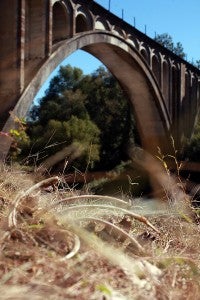Battlefield now dumping ground
Published 12:15 am Saturday, October 25, 2014
BOVINA — The buzz of flies above the dead bodies at the historic battleground is almost deafening.
More than 150 years later, the stench of death hangs heavy in the air at the Big Black River Bridge where troops once under command of Confederate Lt. Gen. John C. Pemberton retreated from Hinds County en route to Vicksburg after a bloody defeat at Champion Hill.
Where soldiers once fell in battle, poached animal carcasses lay in rot —their limbs and bones stacked high and blackened or bleached by the sun. Alongside the rotten deer legs and rib cages are shotgun shells, bullet casings of multiple caliber and garbage bags full of dirty diapers and other unmentionables.
“It could be dressed up a little bit. It’s a dumping ground, but it shouldn’t be,” said Andrew Burch who frequently visits the river bridge “as a place to get away.”

A deer’s ribcage lays discarded beside the Big Black River Wednesday morning near Rebel Bridge on Warriors Trail. (Justin Sellers/The Vicksburg Post)
The trash and carcasses were piled this week on the rock covered bank of the river between the current Kansas City Southern railroad bridge constructed long after the Civil War and the site of a bridge Pemberton’s troops burned in their retreat. A few yards down river, the remnants of the Confederate steamer Dot remain visible during times of low water.
“It’s just gotten to where anytime I ride through, I never know what I’m going to see,” Burch said.
The majority of fighting at Big Black River Bridge took place in Hinds County in what is now a cornfield. Union Gen. Ulysses S. Grant’s son, Fred, was wounded there, as was Confederate Gen. Stephen D. Lee.
Though it is less famous than the battles during the Vicksburg Campaign, Big Black River Bridge still draws plenty of interest from tourists, said Jordan Rushing, a historian with the Old Court House Museum.
“It’s been pretty frequently this year. I would say I get asked about it a few times a month,” Rushing said. “I get more questions about that than the other battles like Raymond.”
Despite the historical status of the site, it has been used for years as a dumping ground for poached animal carcasses, Sheriff Martin Pace said.
“That area has been problematic for sometime. We continue to work with the Department of Wildlife Fisheries and Parks,” Pace said. “Most of what you see out there are the remnants of illegal deer hunting, most of which is at night.”
Catching someone in the act of tossing out an animal carcass is difficult, Pace said.
“Areas like that that are extremely isolated on a road that is seldom traveled, it makes it easy for someone to dump a deer carcass or for that matter anything else in a matter of minutes and drive off undetached,” Pace said.
Burch suggested the county give priority to cleaning up the area.
“Given the history of that area, it seems like the powers that be would say lets look a little further and do something about it and make it a nicer area,” he said.





